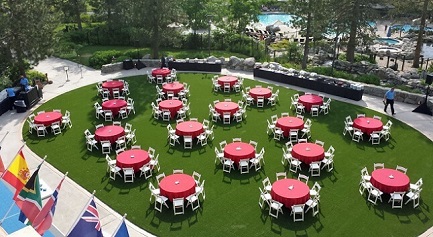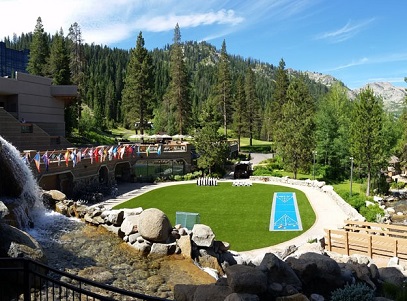 NATIONAL REPORT—Last June, Nevada Gov. Steve Sisolak signed into law a bill supported by the Southern Nevada Water Authority that requires the removal of “useless,” or purely decorative, grass throughout the Las Vegas Valley by the end of 2026. The Valley has been undergoing a severe drought as indicated by the U.S. Drought Monitor. Useless grass, also known as nonfunctional turf, is found around Southern Nevada business complexes (including hotels and resorts), along streets in HOA communities, and in traffic circles and medians. It is grass that provides no recreational value.
NATIONAL REPORT—Last June, Nevada Gov. Steve Sisolak signed into law a bill supported by the Southern Nevada Water Authority that requires the removal of “useless,” or purely decorative, grass throughout the Las Vegas Valley by the end of 2026. The Valley has been undergoing a severe drought as indicated by the U.S. Drought Monitor. Useless grass, also known as nonfunctional turf, is found around Southern Nevada business complexes (including hotels and resorts), along streets in HOA communities, and in traffic circles and medians. It is grass that provides no recreational value.
The California Air Resources Board has voted to update California’s Small Off-Road Engine Regulations, effectively banning the sale of gas-powered equipment using small off-road engines (SORE), which includes all lawn and landscape equipment in 2024.
According to the Synthetic Turf Council (STC), in Florida, erupting algae blooms are wildly out of balance due to agricultural and residential runoff. The U.S. Environmental Protection Agency (EPA) indicates that, “The most effective preventative measures are those that seek to control anthropogenic influences that promote blooms such as the leaching and runoff of excess nutrients.” (Also see Beyond Pesticides, July 20, 2018.)
One option to replace decorative natural grass at hotels and resorts and elsewhere is synthetic grass. The technology behind synthetic grass has evolved in recent years, making it an even more attractive alternative to real grass or stones. According to Stan Pennington, CEO of Grass!365, a provider of a synthetic grass system called IntelliTurf, it is not just Nevada, or the most drought-stricken states, where synthetic turf is a logical replacement for natural grass. In fact, his company’s biggest installation is in the New England area.
Installation Examples from the STC
Featuring world-class amenities and ocean front views, San Diego Mission Bay Resort boasts 23,000 square feet of synthetic turf. Having suffered from dry, brittle grass due to extreme heat and little precipitation, San Diego Mission Bay Resort chose synthetic grass to alleviate their watering needs and create a beautiful, lush, tropical atmosphere for guests to enjoy year-round. The newly landscaped area is now regularly utilized for weddings and banquets, providing solid support for tables, chairs, and high heels with no concern for sinking or damage to the yard. By utilizing synthetic turf, the resort can schedule an unlimited number of events as no time is needed for these areas to recover from high traffic. This project has improved not only the appearance of the resort for guests to enjoy, but also the ocean front property viewed by the public on their daily walks up the coast. Meticulously installed to accommodate for a variety of landscape features including palm trees and walkways, the selected synthetic turf is an environmentally friendly choice for the dry San Diego heat.
In Las Vegas, premier locations such as the Wynn Hotel, the Bellagio, Venetian, and Caesars Palace now feature synthetic grass. Last year, the Wynn Hotel alone saved 143,748,000 gallons of water formerly used for landscaping. Other hotels in urban locations are adding synthetic turf to maximize formerly unused areas. The Mandarin Oriental Hotel in New York delights guests with a 38th floor terrace yoga deck using synthetic grass. Overlooking San Francisco’s waterfront, the Hotel Vitale lined their fourth story rooftop with synthetic grass to create a multi-use area.
STC concurs, saying rooftops once deemed unusable for high rises and residential buildings can now feature inviting green area. Hotels that had to restrict the use of lawns for parties and events can now schedule as many functions as they can book.
Environmental Advantages
Pennington agrees that synthetic grass has many environmental upsides when compared to natural grass, the greatest of which is water savings. Other advantages include elimination of exhaust fumes from the machinery cutting it, and the elimination of fertilizers and other chemicals that are typically applied. Gone too is the noise pollution from mowers, weed wackers and blowers. With some synthetic grass, such as that supplied by Grass!365, there is also the opportunity to recycle the grass and its SealTuft backing at the end of its life. “You can continually make another plastic product out of it,” Pennington says.
Synthetic grass technology has been evolving over the years. In fact, Grass!365’s SealTuft backing enables it to drain over 1,000 inches per hour (more than 30 times the industry average). Pennington says his company is in the testing phase for capturing that drained water underground for reuse.
In addition to those areas considered purely decorative, synthetic grass can be used as a cover for special events or for outdoor dog runs at pet-friendly resorts and hotels. “The last thing you want to do is use the islands in the parking lot,” Pennington says.
“A lot of our work will be a lawn off a pool or other amenity,” Pennington adds. As a cover for playgrounds, with a safe padding below, is another potential use, as well as for golf greens or bocce courts. Synthetic grass can also replace heat-absorbing pavers or cement in certain areas.
Synthetic Grass Purchasing Advice
 When asked for advice on what to consider when buying synthetic grass, Pennington said, “Who’s doing the installation matters more than the product itself.”
When asked for advice on what to consider when buying synthetic grass, Pennington said, “Who’s doing the installation matters more than the product itself.”
Adds STC, “Research the synthetic grass manufacturer and installation company with whom you may contract. Carefully check their warranty, website, references, and complaint record with the Better Business Bureau and the local consumer affairs office. Visit some of their installations, particularly those that are several years old. Be sure to understand how customer questions, service issues, and warranty claims will be handled. Do business with companies that you believe are most likely to be in business to respond to a warranty claim throughout the warranty period.
Synthetic turf manufacturers, suppliers, design professionals and installers who are STC members have agreed to abide by the STC’s Code of Ethics and Code of Conduct. STC members who have earned the designation of “STC Certified” have made additional business and performance commitments to benefit their customers.
The STC developed the Certified Synthetic Turf Installer Program to promote certified individual installers who promote industry recognized best practices, abide by the STC Code of Ethics, and meet all continuing education requirements. The CSTI credential is for experienced and qualified installers of landscape synthetic grass who meet the minimum installation experience requirements (minimum of 10 landscape and recreation projects and a minimum of 20,000 sq. ft.).
The installation contractor should provide you with the following:
- Several references you should talk with, and several projects completed during the past several years that you should personally inspect; and
- A sample of the warranty or warranties prior to signing the contract.
Carefully review and understand:
- the history and stability of the company providing the warranty—the warranty is only as good as the company that stands behind it when a warranty claim is submitted, perhaps years after the synthetic grass is installed;
- warranty terms for defects in workmanship and material, including durability, fading, and premature wear or degradation from ultra-violet radiation from the sun;
- warranty limitations and remedies;
- conditions, if any, which might void or limit coverage under the warranty;
- person and company obligated to respond to a warranty claim and fulfill the warranty terms; and
- procedures for filing a warranty claim, particularly against a foreign manufacturer.
The STC recommends that buyers and decision-makers engage with and include their synthetic turf manager or groundskeeper in the selection process in order for the manager to better understand, plan and maintain the turf application during its useful life.
Minimum Guidelines Developed for Synthetic Turf Systems
In an effort to respond to the requests of municipalities, homeowners’ associations, and landscape architects, and design professionals, the STC develops minimum guidelines for synthetic turf systems. There are many styles and systems for the synthetic grass that is engineered for commercial landscape use. Some styles and systems may not meet STC minimum quality guidelines, and others may greatly exceed them; nevertheless, these products might qualify as a quality product for the intended application. Therefore, it is most important to carefully research the companies that you are considering to make and install the synthetic grass you have selected. Do business with companies and people you trust because of their proven experience and professionalism.
- Insist on a quality product that meets or exceeds the STC’s minimum guidelines, and that is identified as appropriate for its intended use;
- Review all documents, including work plans, construction schedules, and contractor warranties. Make sure all agreed terms and extras are in writing;
- Keep the synthetic grass sample you select and compare it before installation to the product that is delivered.
For more information about the STC and its members, visit the STC Online Buyer’s Guide and Member Directory at www.syntheticturfcouncil.org.
In regard to synthetic grass maintenance, the STC says:
- Blow off or rake the turf to maintain its look, help eliminate any debris, and stabilize the fibers. Use water to clean up any spills.
- Use water to cool off the grass if it gets too hot for children to play on.
- Shaded areas will always be cool enough for play.
- When synthetic turf fibers are not brushed vertically, they lean to one side, and this creates a shiny appearance.
- If your start to notice a shine on the lawn, you should call your contractor or installer to come out and power broom the fibers. This occasional power brooming helps the turf last longer.
Glenn Hasek can be reached at greenlodgingnews@gmail.com.





